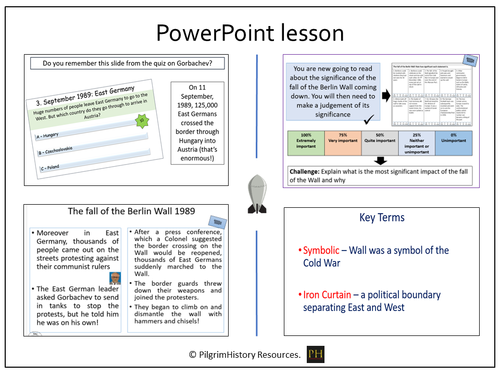



Superpower Relations and the Cold War, 1941-91
The aim of this lesson is to analyse the significance of the fall of the Berlin Wall and the impact upon Europe with the collapse of the Soviet Union.
Students begin by recapping key facts about the Wall and how citizens of East Germany could travel to the west through Austria.
They will learn how the fall and destruction of the wall came about an given significance ratings to ten consequences, which students can use to complete an extended writing task.
There are some excellent video links to watch as well as images to decipher during the lesson.
A GCSE question tackling the importance of the fall of the wall can be completed at the end of the lesson with help and a writing frame provided.
The lesson is enquiry based with a key question using a lightbulb posed at the start of the lesson and revisited throughout this and subsequent lessons to show the progress of learning.
The lessons in this bundle are therefore linked together to build up a picture of how diplomacy, propaganda and spying led two Superpowers with opposing political ideologies to create tensions, rivalries and distrust as well as subsequently forming mutual understanding and cooperation over the time period in question.
The resource includes retrieval practice, suggested teaching strategies, differentiated material and GCSE question practice.
It comes in PowerPoint format if there is a wish to adapt and change.
Something went wrong, please try again later.
This resource hasn't been reviewed yet
To ensure quality for our reviews, only customers who have purchased this resource can review it
Report this resourceto let us know if it violates our terms and conditions.
Our customer service team will review your report and will be in touch.